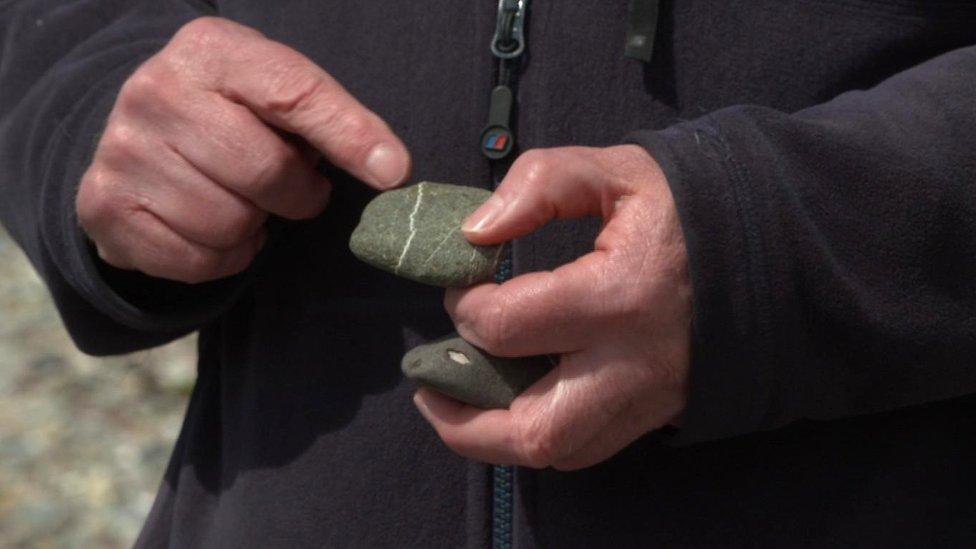Searching for life on Mars from a Scottish island
- Published
Professor John Parnell explains his work on the island of Cumbrae
In a flat on the island of Cumbrae, off the west coast of Scotland, a geologist has turned his kitchen into a hub in the search for signs of life on Mars.
Prof John Parnell learned to spot the signs of life in rocks while studying oil and gas exploration at the University of Aberdeen.
He is now using his skills to train scientists working on Europe's first Mars rover.
Those running the project will make decisions based on images sent back by the rover as it travels over the planet's surface.
But they need practice interpreting the pictures that will beamed back to them from millions of miles away.
Using a video link from his kitchen in Millport, the seaside town on the popular island, Prof Parnell guides the scientists on where they should look for evidence of life as they take the rover's instruments on practice runs in field sites around Europe.

The ExoMars rover is named after the scientist Rosalind Franklin, who helped discover DNA
The European Space Agency's (Esa) Mars rover project had been due to launch on a Russian rocket in September and land eight months later but the war in Ukraine has made this "very unlikely".
Scientists still hope they can explore the red planet in 2023.
Prof John Parnell told BBC Scotland's The Nine: "The search for life on Mars will be through the eyes of a rover, trundling over the surface.
"What we need to do is develop the skill to look at those images and predict which samples are worth examining in more detail. Which samples might have evidence of either life, or habitats for life."
Scientists working on the ExoMars mission, the European Space Agency's first attempt to send a rover to Mars, will only have a few chances to sample rocks on the red planet.

This kitchen on Millport is a base for training European Space Agency scientists
Prof Parnell said: "We only have a certain number of detailed analyses that are possible so one really has to get that right.
"There's also a tactical approach to this. It may be that we feel that we're losing power more quickly than we expected.
"In that case it's important you take the opportunities you've got rather than leaving them for an opportunity that may not come about."
The search for life on Mars could answer important questions about how life formed on Earth, and what our planet looked like millions of years ago.
The instrument that will do this has been developed by teams at universities in Leicester and Madrid.

Dr Hannah Lerman will use Professor Parnell's training to decide which rocks to sample on Mars
Dr Hannah Lerman from the University of Leicester will be part of the team that decides which rock to sample on Mars.
She said the training from Prof Parnell by video link was "potentially even more enlightening than if we were all in the field".
"He was looking through a camera, which is exactly what we'll be doing on Mars," she explained.
"We were there in the field almost acting like the rover. He was then able to speak from his experience how he would then analyse that."
How to spot signs of life

Professor Parnell says the beach on Millport is an excellent place to spots signs of life
Walking along the beach near his Millport home, Prof Parnell stops to pick up two rocks.
"This one has gas bubbles in it," he said.
"That is a potential habitat, because that represents space where microbes could live beneath the surface."
"We know that similar rocks with gas bubbles like this occur on Mars, so it's a good find."
The other rock he picked up had a vein of minerals, where water would have passed through, which he said also suggested a potential habitat for life.
In fact, Prof Parnell said Millport beach was an excellent place to learn to spot the signs of life, because of volcanic pebbles formed hundreds of millions of years ago on the island, which are also found on Mars.
"People do walk along this beach looking out quite closely, but they're looking for other things," he said.
"They're looking for flotsam and jetsam, they're looking for coins. Not many of them are looking for bits of Mars like I am."
He said he was also optimistic that signs of life might be found on the red planet.
"We know that on Earth, microbes require space to live and to move, they require water, they require nutrients as an energy source," he explained.
"But life can crop up in unusual places. We have to be prepared for the unexpected."
- Published11 October 2020

- Published28 February 2022